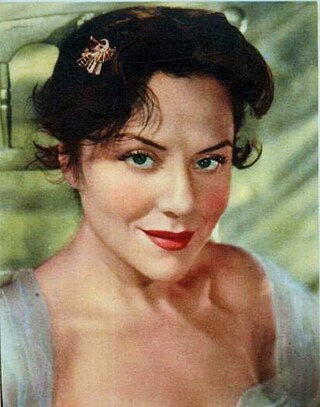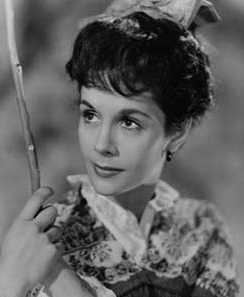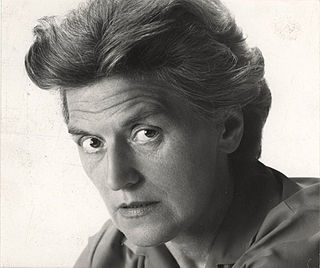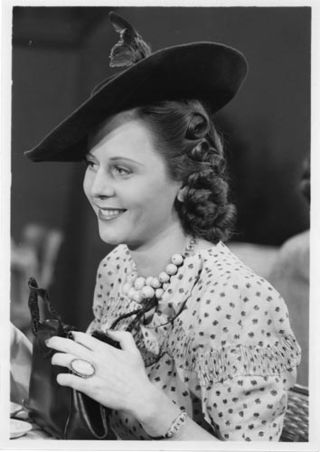
The Teatro Colón is a historic opera house in Buenos Aires, Argentina. It is considered one of the ten best opera houses in the world by National Geographic. According to a survey carried out by the acoustics expert Leo Beranek among leading international opera and orchestra directors, the Teatro Colón has the room with the best acoustics for opera and the second best for concerts in the world.

Avenida Corrientes is one of the principal thoroughfares of the Argentine capital of Buenos Aires. Over a central stretch it is popularly known as "The Street that Never Sleeps" widely considered Buenos Aires' answer to Broadway as it concentrates many of the main theatres and cinemas as well as famous pizzerias and cafes, being intimately tied to the tango and the porteño sense of identity. Like the parallel avenues Santa Fe, Córdoba, and San Juan, it takes its name from one of the Provinces of Argentina.

Amelia Bence was an Argentine film actress and one of the divas of the Golden Age of Argentine Cinema (1940–1960).

Delia Amadora García Gerboles better known as Delia Garcés was an Argentine film actress of the Golden Age of Argentine Cinema (1940–1960). She made almost 30 appearances in film between 1937 and 1959 and acted on stage from 1936 to 1966. She won the Premios Sur Best Actress award three times from the Argentine Academy of Cinematography Arts and Sciences, as well as the Argentine Film Critics Association's Silver Condor Award for Best Actress, the Premios Leopold Torre Nilsson, Premio Pablo Podestá, and the inaugural ACE Platinum Lifetime Achievement Award from the Asociación de Cronistas del Espectáculo.

Laura Ana "Tita" Merello was an Argentine film actress, tango dancer and singer of the Golden Age of Argentine Cinema (1940–1960). In her six decades in Argentine entertainment, at the time of her death, she had filmed over thirty movies, premiered twenty plays, had nine television appearances, completed three radio series and had had countless appearances in print media. She was one of the singers who emerged in the 1920s along with Azucena Maizani, Libertad Lamarque, Ada Falcón, and Rosita Quiroga, who created the female voices of tango. She was primarily remembered for the songs "Se dice de mí" and "La milonga y yo".

China Zorrilla was an Uruguayan theater, film, and television actress, also director, producer and writer. An immensely popular star in the Rioplatense area, she is often regarded as a "Grand Dame" of the South American theater stage.

Juan José Castro was an Argentine composer and conductor.

Alita Blanca Barchigia, better known as Alita Román, was an Argentine film actress of the Golden Age of Argentine Cinema (1940–1960).

The Avenida Theatre is a theatre in Buenos Aires, Argentina.

Annemarie Heinrich was a German-born naturalized Argentine photographer, who specialized in portraits and nude photographs. Heinrich is considered one of Argentina's most important photographers.

Olinda Bozán was an Argentine film actress and comedian of the Golden Age of Argentine Cinema (1940–1960). Born into a circus family, she acted on the vaudeville circuit, and performed in silent and sound movies. She was trained by the Podestá brothers, one of whom she married, who have one of the most prestigious Argentine acting awards named for them. Bozán appeared in 75 films and was considered one of the best comic actors of Argentine cinema in the 20th century.

Dora Gález (1903–2002) was a pioneering Argentine actress and vedette. She was one of the first stars of the Maipo Theater, and given the title of the "nightingale of the house". Other early co-stars with whom she worked were Carmen Lamas, Gloria Guzmán and Tita Merello. In 1924, she was in the cast of Roberto L. Cayol's Revue ¿Quién dijo miedo? which featured music by Arturo De Bassi along with Iris Marga, César Fiaschi, Carmen Lamas, and the debut performance of Tita Merello.

Aída Luz was an Argentine actress who primarily worked during the Golden Age of Argentine Cinema, performing on both stage and in films. She won multiple awards for her performances including the Martín Fierro Awards, the ACE de Oro, the Premios Estrella de Mar and the Golden Condor from the Argentine Film Critics Association.

Multiteatro is a theater complex located at 1283 Avenida Corrientes, in Buenos Aires, Argentina on the site of the historical Teatro Smart and Teatro and Cinema Blanca Podestá.

The Escuela Técnica Raggio is a government-run secondary school in Buenos Aires, Argentina. The school is located in Nuñez, on Avenida del Libertador near Avenida General Paz.
Ana María González is a Spanish lyric soprano trained in Argentina, known for performing at the Teatro Colón from 1973 to 1994. Although associated with the Italian lyric repertoire, she also excelled in lyric soprano roles of the French repertoire such as Manon, Marguerite, and Juliette, which brought her international fame.

Myrtha Garbarini (1926–2015) was an Argentine operatic soprano who initially was a singer of chamber music and oratorios. From 1958, she performed at the Teatro Colón in Buenos Aires singing in some 25 operas including Le Nozze di Figaro, La Bohème and La Traviata. Garbarini was a co-founder of the Ópera de Cámara del Teatro Colón (1968). In addition to appearances in South America, she sang in the United States, Austria and Germany.

Rosita Rodrigo was a Spanish actress, vedette, dancer and songwriter, highly successful in Spain, Mexico, Cuba, and Argentina. Among her most popular songs are the Valencian zarzuela, "Les barraques" and "Muñequita de trapo." She was also linked to politics, such as her relationship with Alfonso XIII.

Hortensia Arnaud was a pioneering Argentine dancer, vedette, and actress of film and stage. Arnaud made significant incursions during the heyday of cinematography and revue theater. Above all, she was a pioneer bataclana and premier dancer in Buenos Aires during the 1920s and 1930s.
















